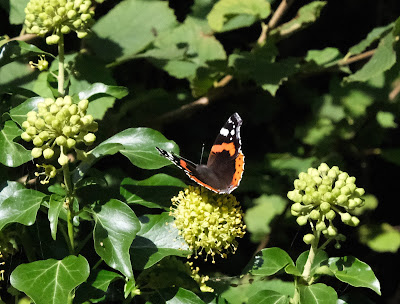The Hardy Monument
Today we finally got round to visiting the Hardy Monument and doing a circular walk inland from it. The Hardy Monument is a twenty-two metre (70 feet) single column built of local Portland stone and perched on the summit of Blackdown Hill, above the village of Portesham. Although the Monument looks like a chimney, it is in fact intended to represent a spyglass. The Monument was restored in 1900 by Hardy's descendants and given to the National Trust in 1938.
The Monument commemorates Thomas Masterman Hardy who was born in nearby Portesham in 1769 and died in 1839. He was the Captain of Nelson's flagships, especially the Victory, and was later an Admiral himself. He was principally famous for being the recipient of Nelson's dying words - "kiss me Hardy".
The view above conceals a doorway in the rear of the monument. There are 122 steps inside the monument and a small viewing platform on top. It is of course currently closed.
Before we set off we noted the splendid views down towards Portland.
We headed downhill passing a tree with a series of carved rocks bearing the message: Be still, Close your eyes, Be still, Listen. Obviously we were in too much of hurry to get into our walk to pay any attention.
The path continued through woodland and then a field-edge path to reach a view point looking down to near to Abbotsbury. You can see the Fleet along with the Chapel of St Catherine on its hill.
We continued along this path to enjoy further wonderful views ...
... and then reach a road junction.We now headed inland along a field edge path to reach the KIngston Russell Stone Circle, a rather minimal circle if truth be told. We wondered if the two people sitting there had just had a domestic.
We headed across the large field and passed some ancient grassy mounds. The next section was quite stressful in that the directions suddenly became sparse and approximate. We struggled our way across fields and streams to eventually reach Littlebredy. This is an estate village which was once the property of Cerne Abbey. We passed the Village Hall and another building ...
... to reach the attractive church of St Michael and All Angels. It is a medieval church largely rebuilt in the mid 19th century.
This was quickly followed by the Bridehead Estate Estate Yard with its Blacksmiths Cottage and Old Forge. We then followed an estate road, catching a glimpse of Bridehead through the trees. The house dates from 1630, but was was rebuilt and extended in the mid 19th century.
We climbed a steep hill to reach a road, which we soon left to follow a woodland path for a mile of so back to the Monument. We missed a turning towards the end and overshot the Monument, but fortunately a dog walker pointed us towards a path which led upwards to it.
Conditions: bright and sunny.
Distance: 7 miles.
From: 50 walks in Dorset.
Map: Explorer OL15 (Purbeck & South Dorset).



















































